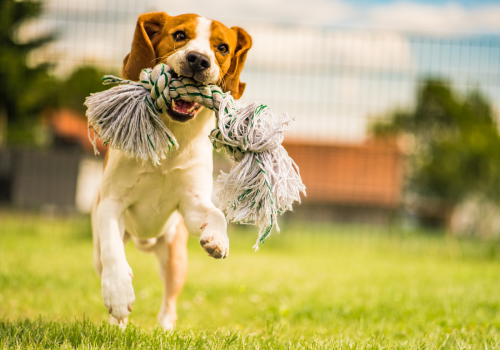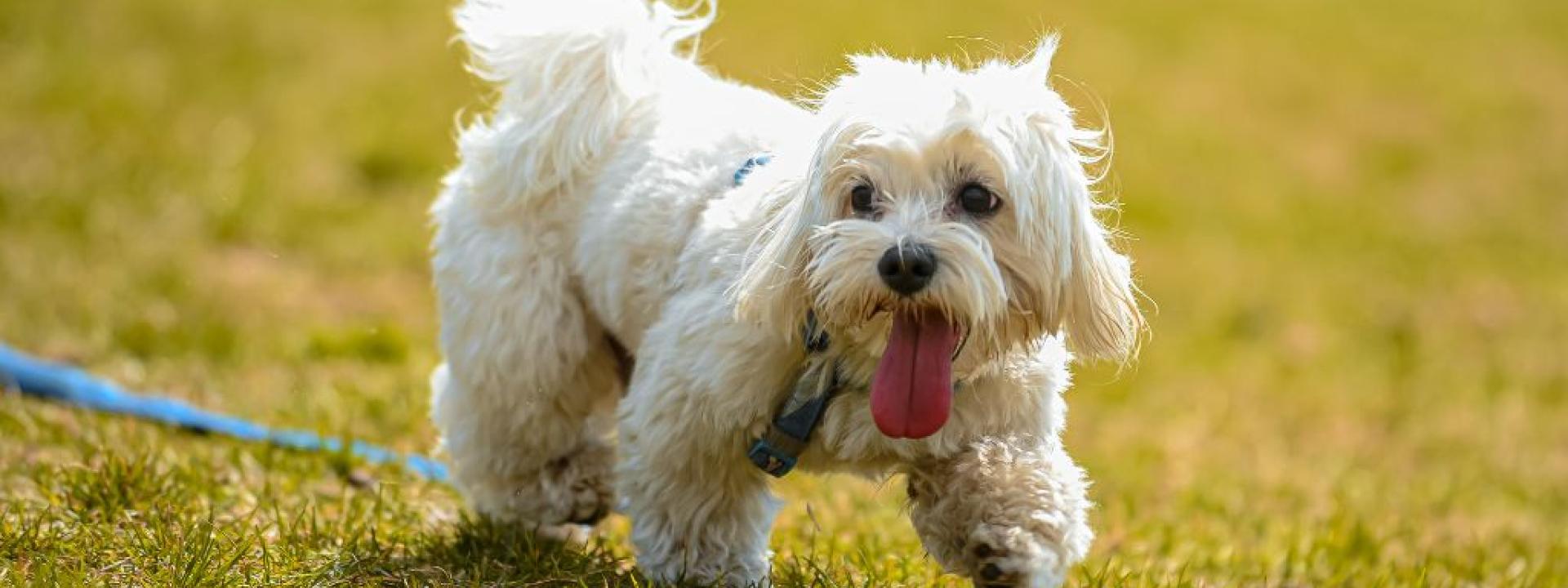In theory, we all know that our dogs need exercise, but you may be wondering just how much or how often, especially if your pet is new to your home. Congratulations on doing your due diligence by turning to the web for answers. We’re glad you found us, as you can often stumble across misinformation on pet care from well-meaning bloggers and fellow pet parents. At Veterinary Medical Center, we work extremely hard to bring you the accurate information you need to raise a happy and healthy pup. For that reason, we’ve taken FAQs on dog exercise and answered them as thoroughly as possible, so you have the trusted information you need to care for your canine companion.
If you’re looking for a highly trained veterinarian in Union City, CA, we’d love to see your dog and ensure they’re getting the optimal amount of exercise, so please call us at (510) 441-8500.
How much exercise does my dog need?
How much exercise your dog needs depends on the age and breed of your dog and if your dog is currently in shape or not, but we want your pet to be up and active on a daily basis. Also, you want to consider if the dog has any musculoskeletal issues. Usually, several times a day will be best. Even a short walk can be what some smaller dogs need, but more active dogs, especially those a bit larger and younger, often need longer walks or more intense exercise. However, exercise is also critical for senior dogs as they need to keep their joints tight and keep up their muscle tone and strength.
How does exercise impact the health and wellbeing of my dog?
It’s the same as humans, as we need to exercise and remain healthy for our cardiovascular and respiratory systems. All of it relies on the shape that you are in regarding oxygen levels, muscle tone, and even fat and calorie burning. Exercise is a great way to keep your dog in shape and healthy for several years.
There are also many different conditions that exercise can help prevent in our dogs. The number one thing is going to be obesity. Unfortunately, obesity is something we see far too often in our canine species. And just as we hear about in our human medicine, there are many different ailments and diseases associated with obesity.
In our larger breed dogs that don't get enough exercise, excessive weight is tough on their joints. It leads to osteoarthritis and significantly decreases overall quality of life. Other metabolic issues are associated with obesity and a lack of exercise in our dogs. Pairing exercise with appropriate diets allows you to ensure the best overall condition for your dog.
Lastly, exercise like long walks, hikes, or playing ball in the park all help to keep the dog engaged with the owner, strengthening that critical bond that will keep your pet happy, healthy, and the loyal companion you want them to be.

How much is too much exercise?
In assessing what’s too much exercise for your dog, we've got to look at several factors. Again, the age and overall state of health of the dog you're dealing with are essential considerations. There can be limiting environmental factors, depending on the breed of the dog. For example, if you have a bulldog and take that dog out in 95-degree weather, you better not exercise them very much because they don’t have a big enough windpipe to keep themselves cool. They will overheat, and you will end up at the veterinarian. But if it's a chilly day and it’s an active working dog such as an Australian Shepherd, Labrador, or a cattle dog, you can work them quite hard. You often have to stop because the dog will want to keep going. And you know if their tongue is hanging out, they're pushing it to the limit, so use your judgment.
When puppies are 15 to 18 weeks of age, they can go quite a long way. However, small dog breeds like Yorkshire terriers, for example, cannot store enough of a readily convertible carbohydrate, meaning we can exercise them too much, and their blood sugars will fall too low. And if their blood sugar drops too low, they either collapse, seizure, or both! So with puppies that are a tiny dog breed, we have to be careful about over-exercising them. And with a dog like the Yorkshire terrier, which comes in at about 15 ounces, you also want to feed them four, five, or even six times a day (at least four) to make sure that there's always something in their system because we don't want to end up pushing their blood sugar too low.
Ultimately, many of our dogs are good about letting us know when they are tiring or reaching the point where they don't want to continue exercising. It’s critical to judge the individual dog. But again, be very cautious about overdoing it with exercising your dogs in the summertime.
What are some ways to exercise my dog outside?
The possibilities for exercising your dog outside are seemingly endless, obviously depending on where you live and the weather during different times of the year.

Some ideas for exercising your dog outside are:
- Go on a hike
- Go for a run
- Take them to a dog park (unless they’ve shown aggression towards other dogs)
- Have your dog go for a nice swim or a lap in the pond or the pool (if you need help knowing whether a body of water is safe for your dog, please ask your veterinarian)
- Throw the ball or frisbee with the dog
- Take them through an agility course
Obedience training is also a lower level of exercise, although some can be pretty intense. Anything that will get your dog up and moving will combat obesity and is excellent for their mental and physical health (and yours!).
What are some ways to exercise my dog inside?
When it's colder, or even when it's too hot, there are things we can do inside—of course, depending on the amount of space. You just have to get creative.
Some things you can do with your dog to exercise them inside are:
- Play a good old-fashioned game of hide-and-seek, as that’s an excellent way to promote movement.
- Going up and down the stairs is an excellent form of exercise, so you can throw the ball to the top of the stairs for them.
- Playing tug of war is an excellent way to exercise when done appropriately. However, if your dog has shown signs of aggression, you might ask your veterinarian whether that’s appropriate. It can be a bit controversial in the veterinary community, as some say it creates a situation where you are putting yourself on one side of the equation while pitting yourself against your dog. You know your dog best, so use your judgment.
- There are even treadmill or indoor agility options.
- Use the laser pointer to get them to run some stairs in your home—they’re not just for cats!
Again, you don’t have to get too crazy to think of small ways to get your dog’s blood flowing, even in the heart of the winter season or when the summer daytime temperatures reach potentially dangerous numbers.
What are some health issues that can occur from lack of exercise?
Obesity is the number one problem. It occurs far too often, and it's generally due to too many calories because of treats in the diet combined with a lack of the dog being up and active. Those calories are going to get stored as extra body tissue. We can also see things like the dog being predisposed to certain things like diabetes and arthritis that are harder to manage. Of course, cardiovascular health is essential, as is respiratory health. But ultimately, trying to prevent obesity in our canine patients would be the number one issue we want to make sure we're using exercise for.
What are some ways to motivate my dog to exercise?
Every dog's personality is a little different. Some dogs may love to run and play fetch with you, and that fetch object may be what specifically motivates them. If they love to swim, give them opportunities to swim. We try to avoid using too many treats during exercise because that negates what we're trying to accomplish. Still, if they are food motivated and are doing an outstanding job, it's okay to give them a little piece of a particular treat without overdoing it.
Judging your dog's personality is the most important thing. If they like to go on walks with you, they might even grab the leash and head towards the door. It is essential to identify the activities that they love and the things they associate with those things.
Avoid the dog park if your dog is not social with other dogs, but if they love the dog park, more power to them. And if you work full time or don’t have as much of an opportunity to get your dog the exercise they need, doggy daycare can be an excellent option.
The ASPCA is another excellent resource on how much exercise your dog needs, creative ways to get your dog to exercise, and the considerable impact obesity can have on a pet’s life. If you have further questions about getting your dog to exercise and keeping them as healthy as possible, reach out to your veterinarian. If you live in or near Union City, CA, we’d love to see your dog and help you get them on the path to optimal wellness through exercise, so please don’t hesitate to call us at (510) 441-8500 or email us at [email protected].

